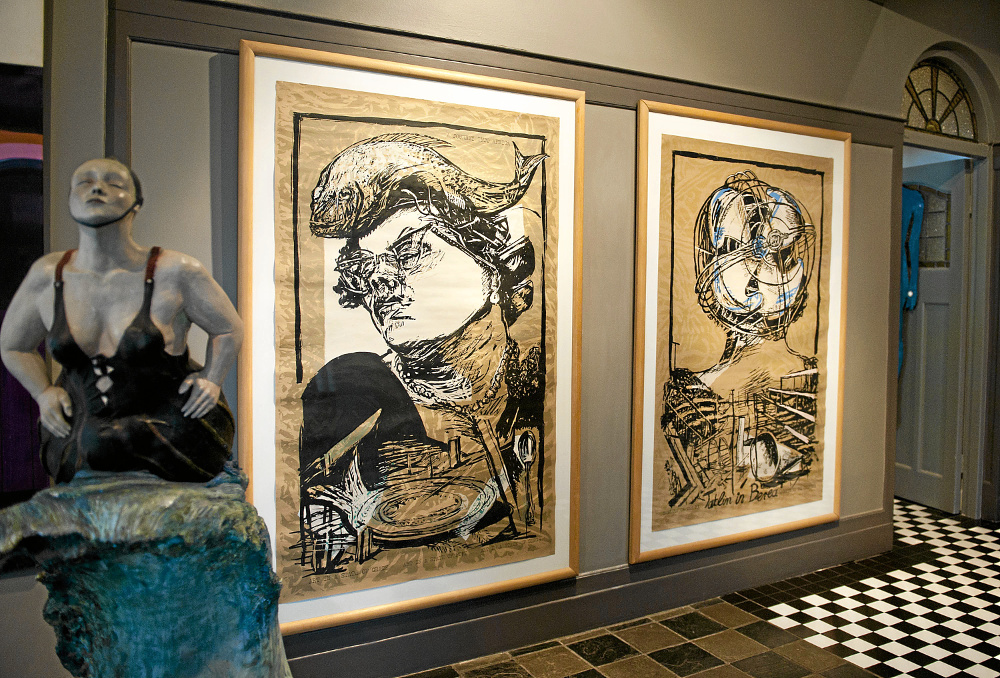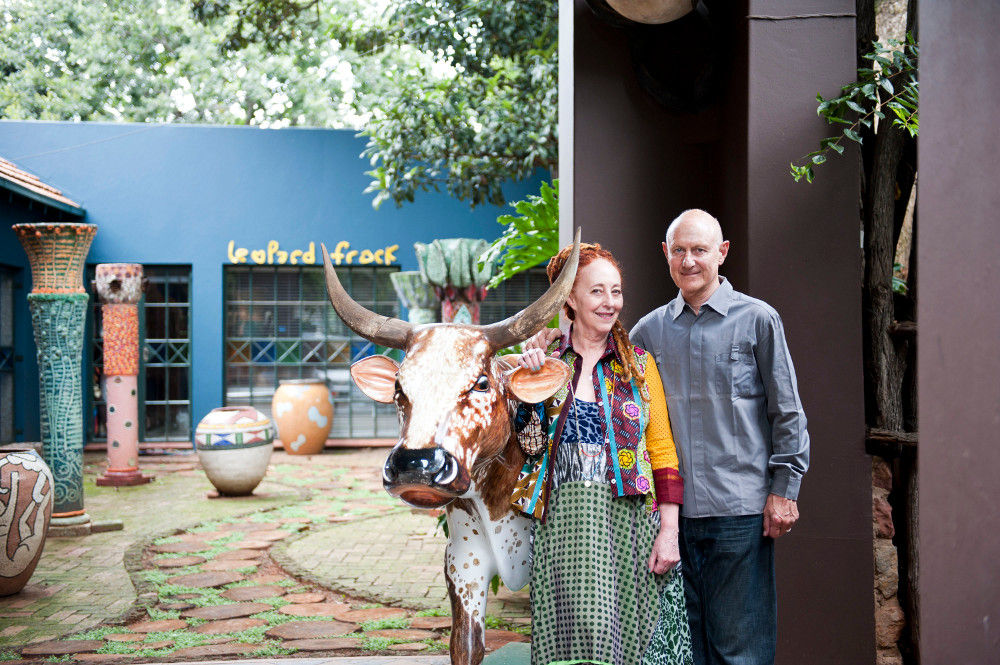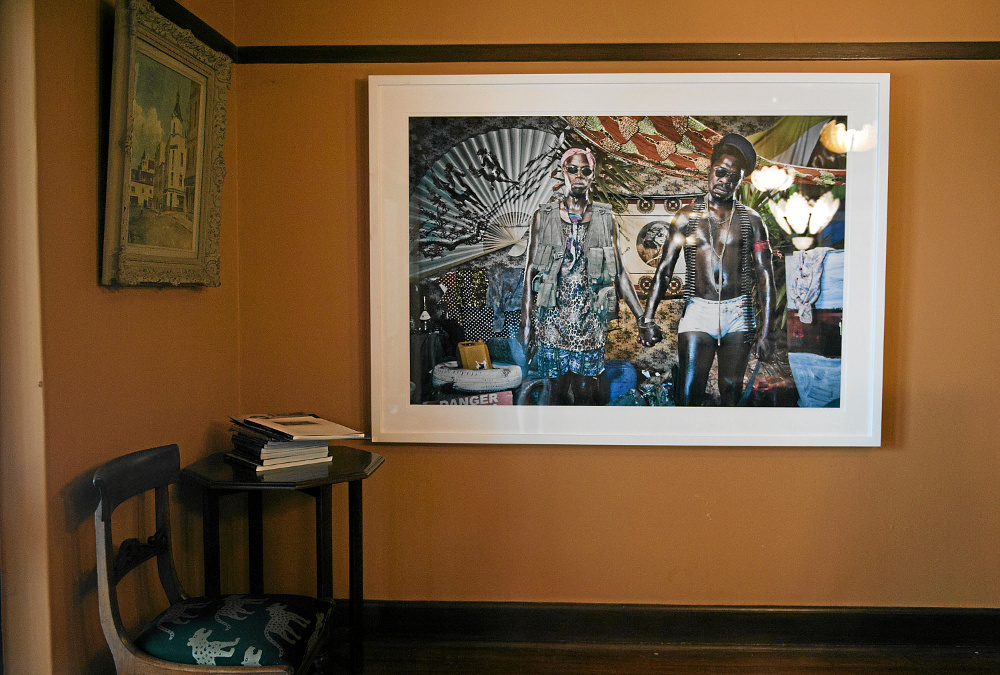Visual feast: Charles Bothner and Marianne Fassler in their home that is a treasure trove of art and craft.
Stepping into fashion designer Marianne Fassler and her husband Charles Bothner's home is like entering a sanctuary for the arts. Bright, hand-painted makarapas (decorated hard hats) rest easy in the wide entranceway, rapturous sculptures and paintings find space between piles of art books, and large-format photographs hang harmoniously on the walls.
Every inch of their Saxonwold home is a platform for art. Even the fireplace has been transformed into the foundation for a wooden Geoffrey Armstrong installation.
Bothner and Fassler, who have been married for 24 years, make no apology or excuse for their passion for acquiring art.
"You don't buy art because you have spare cash. You buy art because you can't live without it," Fassler says. Bothner's passion sprouted when he bought work from a young and fairly unknown William Kentridge for a fraction of the price the artist's work sells for today.
It was in the mid-1980s, and Bothner was in his early 40s. "I had met William, was really interested in his work, and asked him to let me know when he had something I could view to buy," he says.
Fassler's art buying began when, at the age of 22, she could afford to purchase her first piece of art only in instalments from a Jo'burg gallery.
One could say that the award-winning designer's interest in art runs in her blood. Her mother, abstract artist Hannatjie van der Wat, exposed art and its society to a young Fassler.
"In my mother's home, we were surrounded by the likes of [sculptor] Edoardo Villa. David Goldblatt took photographs of my mom in her youth. [Photographer] Sam Haskins was always at our house. I grew up in a home where we loved art."

Some of Marianne Fassler and Charles Bothner's treasured pieces.
It was during these years, being in close proximity to great artists and thinkers in apartheid South Africa, that Fassler says she became socially and politically aware.
"My consciousness has been there for a long time. It comes from the 1970s. It comes from my parents in the 1980s, and growing up in a creative home, where people thought differently. The misconception is that all white people thought the same. There was definitely a movement of dissent."
Like Fassler, Bothner – who left his career in finance to be a part of his family's 112-year-old music business, Bothners – comes from a family of art collectors and a dealer.
As Bothner recalls his art-dealing uncle André Bothner's impact on his love for art collecting, Fassler interjects: "Didn't he give Irma Stern her first exhibition in Johannesburg in 1946?" And it is this almost genetic predisposition for the love of art that has made Bothner and Fassler's collection formidable enough to spill over into their Cape Town apartment.
Before she takes me to see the rest of their collection, we touch on the government's participation in today's local art scene – or lack of it, as she puts it.

"We need a new minister of arts and culture," says Fassler. To which Bothner responds by commenting on the lack of cultural education to promote art appreciation in the school curriculum. "That's also part of the cycle of art appreciation: if you don't get to engage with art on a regular basis, it's quite difficult to value it."
Deeply invested in South African art, their collection features the likes of heavyweights such as Lucas Sithole, Robert Hodgins and Esther Mahlangu, among others, as well as heaps of crafts the couple say they buy "at the side of the road".
Is there a single piece that made you fall in love with visual art?
Fassler: I remember being completely fascinated by a print of Vladimir Tretchikoff's Dying Swan, which was hanging in the bedroom of one of my friend's. This fascination with Tretchi continues, but probably played itself out on a very large scale when I motivated and ultimately collaborated with the Iziko South African National Gallery to stage the first Tretchikoff retrospective in the country.
What was the first artwork you purchased, or were given?
Bothner: A Winston Saoli sculpture.
Fassler: A small, original mixed-media work by [assemblage artist] Christo Coetzee, which I bought in instalments from the Goodman Gallery. Both of these works are still very much a part of our collection.
What elements create a visual masterpiece?
Fassler: I don't necessarily need visual masterpieces to be moved by creativity. I think the work or piece needs to move the viewer in some way. I'm also attracted to unique, often very alternate pieces.
Bothner: [Referring to the Mail & Guardian's interview with former judge Albie Sachs]: Imagination, colour, design, intensity and mystery.

A Kudzanai Chiurai? artwork on the right.
What is the most cherished piece of art in your collection?
Fassler: Both Charles and I find this very difficult to answer. I treasure so many little things, so it is often the moment of collecting or the moment of recognition that stays with me. We often buy art to celebrate specific milestones, something that started early in our relationship. So, it's the memory we cherish, and the work represents that.
Bothner: [Agreeing with Albie Sachs's M&G interview]: They are all equal and special … like my kids.
Marianne, how has your mother's work or thoughts about creativity influenced your approach to art collecting?
In a foreword to the catalogue of her retrospective last year at Smac [Stellenbosch Modern and Contemporary] Art Gallery, I wrote a piece on how I reflect her creativity in my work. Her works are big, bold, colourful and expressive, so I have never been intimidated by scale, colour or boldness in art.
Charles, you come from a finance background. Does the investment factor of buying art motivate your purchases more than aesthetics?
You have to fall for a work of art or craft. It must really say something to you. It's a happy truth that pretty much all the pieces acquired over time are probably worth quite a bit more than their original cost.

A Geoffrey Armstrong installation. (All Photography by Madelene Cronje, M&G)
Which city, event or place do you prefer to purchase art from?
Fassler: We collect only South African art and craft.
Bothner: Our art purchases are overwhelmingly South African, but an essential pleasure when we get to travel is to visit galleries, museums and exhibitions, and to enjoy art experiences like the Venice Biennale, which we try to visit regularly.
Marianne, you've lived in Jo'burg for most, if not all, your life. What art moments in the city have moved you the most?
I see art all around me. Jo'burg inspires my life, my craft, and my personal journey. If I can isolate personal highlights, it would definitely be the two Jo'burg Biennale exhibitions in the early 1990s. And probably the most radical new look at the world around us was Tributaries, curated by Ricky Burnett in 1985 for BMW. It was an original, groundbreaking concept, and changed the way art was thought about in apartheid South Africa. It stimulated a new appreciation of indigenous culture. I think it is still the benchmark.
What is your opinion of the government's support or involvement in the arts?
Fassler: Don't start me on that. I have had so many personal experiences that I have absolutely no hope for any government participation in creative projects. I have had more support from the French government than from my own.
As a couple, what compromises – if any – do you make when acquiring art?
Fassler: We have not had to compromise at all. We love the same things. But now the process is consultative, so it sometimes takes longer to clinch the deal. I am a bit more spontaneous and Charles is a bit more practical or realistic. We have, however, never disagreed about any of our purchases.
Which pieces of art have you struggled to obtain for the collection?
Fassler: Without a doubt, it was our Claudette Schreuders piece. I wanted to buy every single piece in her student exhibition, but they were all sold before the exhibition opened. I then embarked on a long process of pleading and begging until she finally cracked quite a few years later and allowed us to buy [the wooden figures] Barbie & Ken from her grandmother's collection. She is a fabulous, enigmatic, consummate sculptor, and I am really happy to possess those two figures.
Who's your favourite contemporary South Africa artist?
Fassler: There are so many really exciting contemporary South African artists, but we are very interested in photography and video work. We also have our eyes on two artists to add to our stable, but the right works have not presented themselves to us. I am also always on the lookout for interesting pieces of handcrafted furniture or interior pieces. Always South African works.
What was the last piece of art you've bought to date?
Fassler: We purchased two pieces by Kudzanai Chiurai in the past year – Iyeza, which is a video work, and a large photograph from the same series.